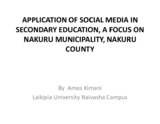SECONDARY EDUCATION, A FOCUS ON NAKURU MUNICIPALITY, NAKURU COUNTY
Abstract
Countries in the developed world embraced opportune
implementations of social media applications to improve the quality
of several services; one being education.
Developing countries are lagging behind in the implementation of
such technologies due to educational system related problems.
Social media, Internet-based tools that promote collaboration and
information sharing can be used in academic settings to promote
student engagement and facilitate better student learning.
Very few studies on use of social media to improve education in
Kenya have been done. The aim of the study was to look at ways
through which social media can be used to improve education in
Kenya, a focus on Nakuru Municipality.
Social learning theory states that people learn from one another
via observation, imitation, and modeling
The study employed a descriptive survey research design. The
target population was 2000 respondents consisting of 10 head
teachers, 90 teachers, 5 education officers in Nakuru Municipality
and 1895 students.
The sample size was be 410 respondents, made up of 10 head
teachers, 18 teachers, and 379 students, one DEO and two Zonal
Quality Assurance and Standards Officers (ZQASOs).
Proportionate sampling was used to select the head teachers
and teachers while purposive sampling was used to select the DEO
and ZQASOs
Questionnaires were used as instruments for collecting data
from the head teachers and teachers while interview schedules
were administered to the DEO and the Zonal Quality Assurance and
Standards Officers (ZQASOs).
Validity of the instruments was done through experts judgment.
Reliability was tested by subjecting the instruments to a pilot
study.
Data analysis was done using descriptive statistics after data
cleaning and coding.
Quantitative data was analyzed using frequency counts, means
and percentages while qualitative data was analyzed by tallying the
numbers of similar responses.
Results of data analysis was be presented using frequency
distribution tables, bar graphs and pie charts
The results of the study were that there are limited application of
social media in education in Nakuru.
Also there was limited access of e-books and other internet based
resources.
Although most students have access to internet, it mostly used for
fun and scarcely utilised for learning.

